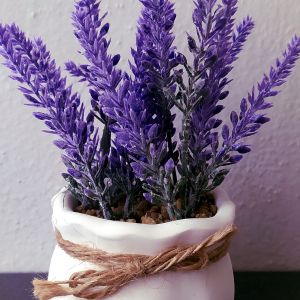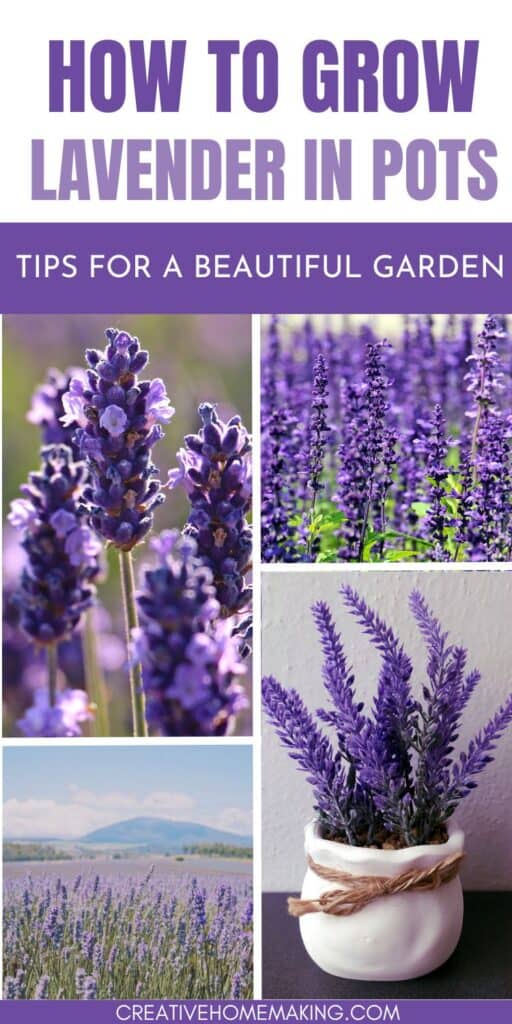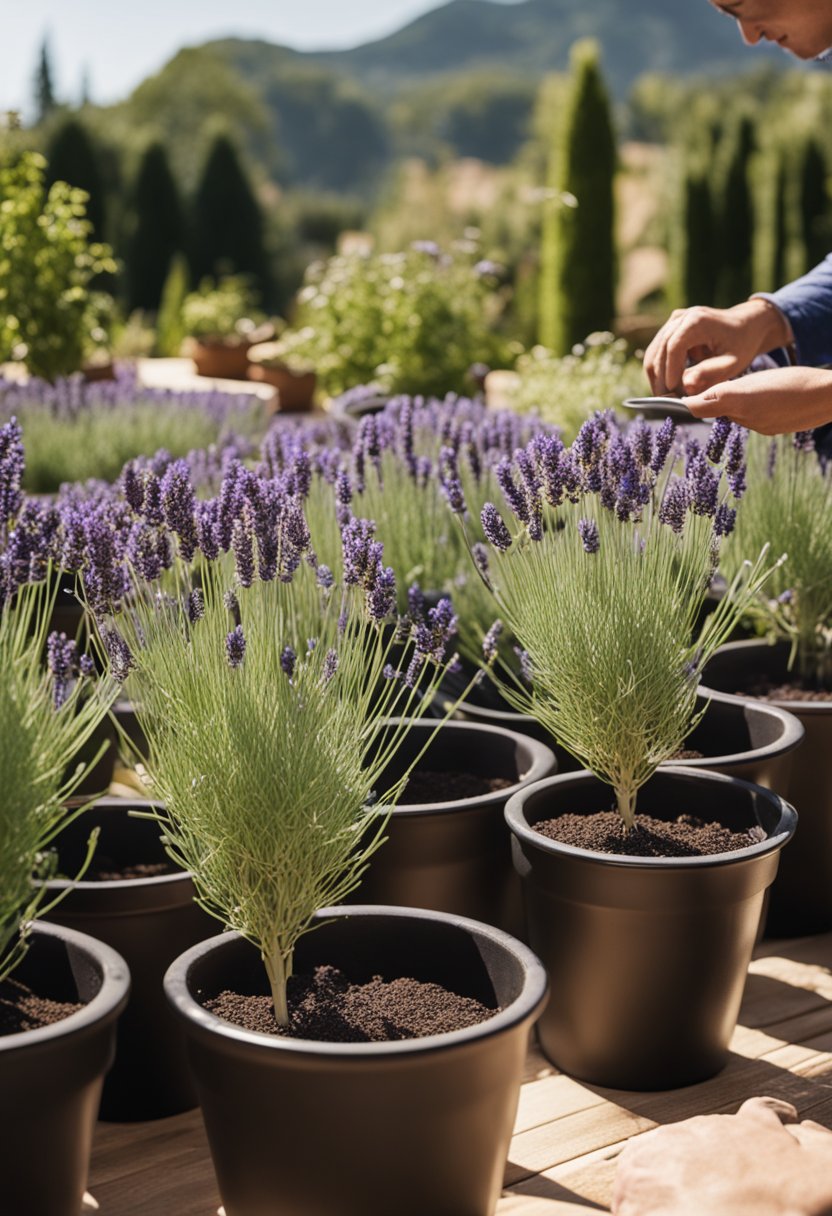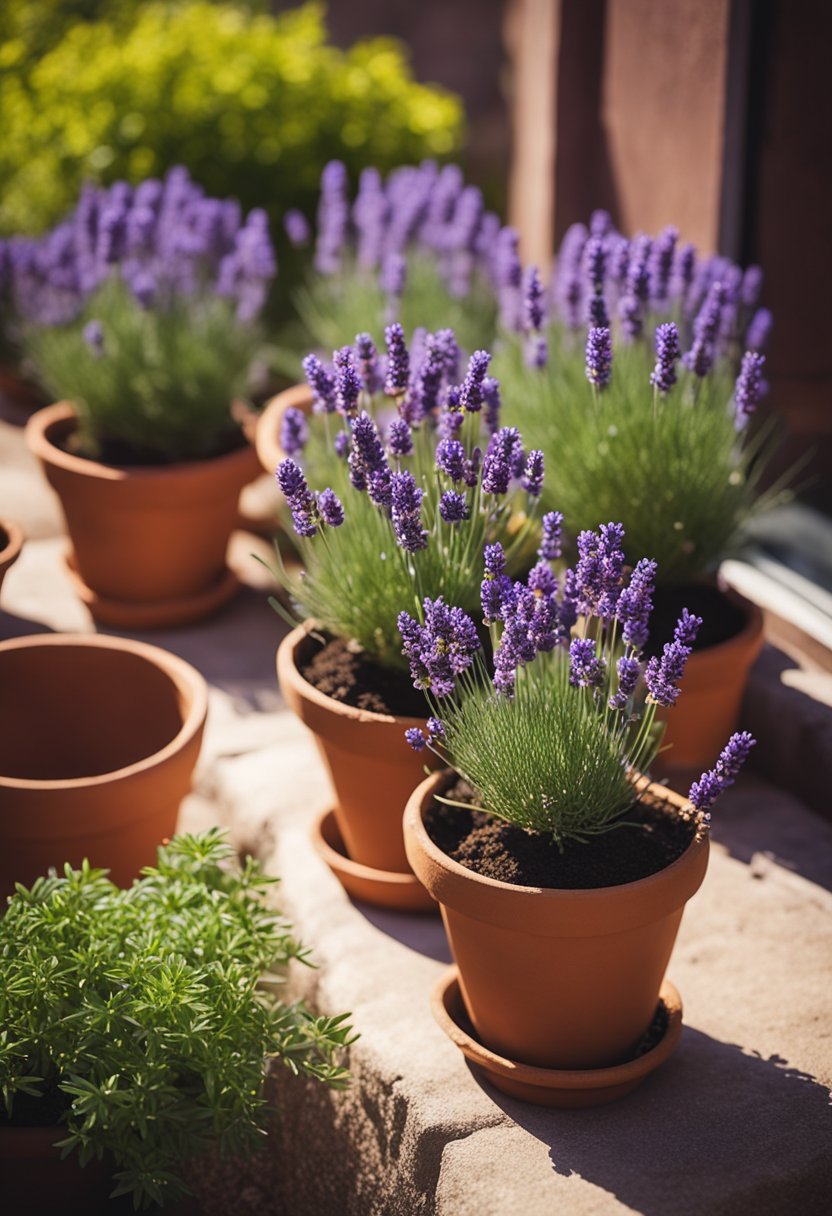Growing lavender in pots is a great way to add color and fragrance to your outdoor living space. Lavender is a versatile plant that can be grown in a variety of containers, making it a perfect choice for those with limited garden space.
This post may contain affiliate links.
With the right care and attention, you can enjoy a beautiful display of lavender blooms all season long.
When choosing a pot for your lavender, it’s important to select one that is large enough to accommodate the plant’s root system.
A pot that is too small can cause the plant to become root-bound, which can lead to stunted growth and poor flowering. A good rule of thumb is to choose a pot that is at least 12 inches in diameter and 12 inches deep.
To ensure your lavender thrives in its pot, it’s important to provide it with the right growing conditions. Lavender prefers well-draining soil and a sunny location, so be sure to choose a spot that receives at least six hours of direct sunlight each day.
Water your lavender regularly, but be careful not to overwater, as this can lead to root rot. With a little bit of care and attention, you can grow beautiful lavender in pots that will add color and fragrance to your outdoor space all season long.
Choosing the Right Pot
When growing lavender in pots, choosing the right pot is crucial for the success of your plant. Here are some factors to consider when selecting a pot:
Related Article: How to Make Lavender Linen Spray
Pot Material
The material of the pot can affect the growth of your lavender. Terracotta pots are a popular choice as they are porous and allow for air and water to move through the pot.
This promotes healthy root growth and prevents the soil from becoming waterlogged. However, terracotta pots can dry out quickly, so it’s important to keep an eye on soil moisture levels.
Containers made of plastic, metal, or ceramic are also suitable for growing lavender. These materials are non-porous, which means they retain moisture better than terracotta pots.
However, they may not provide adequate drainage, so it’s important to ensure there are drainage holes at the bottom of the pot.
Related Article: Deadheading Lavender: A Guide to Promoting Blooms
Pot Size and Drainage
The size of the pot you choose will depend on the size of your lavender plant. Lavender plants have shallow roots, so a pot that is too deep may cause the soil to become waterlogged. A pot that is too small may not provide enough space for the roots to grow.
When selecting a pot, make sure it has drainage holes at the bottom. Without proper drainage, the soil can become waterlogged, which can lead to root rot and other issues. If the pot you choose doesn’t have drainage holes, you can drill them yourself.
Related Article: How Much Water Does Lavender Need: A Guide for Healthy Growth
Soil and Planting
Best Soil Mix
Choosing the right soil mix is crucial for growing healthy lavender plants in pots. Lavender prefers well-draining soil that is not too rich in nutrients. A good soil mix for lavender in pots is a combination of potting mix, perlite, coarse sand, and compost.
You can make your own soil mix by combining 1 part potting mix, 1 part perlite, 1 part coarse sand, and 1/2 part compost. This soil mix will provide excellent drainage and aeration for your lavender plants.
Related Article: How to Make Lavender Oil: A Simple Guide
Planting Lavender
When planting lavender in pots, make sure to choose a container that is at least 12 inches deep and has drainage holes at the bottom. Fill the container with the soil mix, leaving about 1 inch of space at the top.
Gently remove the lavender plant from its container and loosen the roots. Place the plant in the center of the pot and fill in the soil around it. Press the soil down lightly and water the plant well.
It is important to water lavender plants deeply and infrequently. Allow the soil to dry out slightly between waterings to prevent overwatering, which can lead to root rot.
Caring for Potted Lavender
Growing lavender in pots is a great way to enjoy its beautiful fragrance and stunning blooms in a compact space. However, caring for potted lavender requires some attention to detail. Here are some tips to help you keep your lavender healthy and thriving.
Related Article: Types of Lavender: A Guide to Different Varieties
Watering Requirements
Lavender is a drought-tolerant plant that prefers well-drained soil and doesn’t like to be overwatered. Water your potted lavender sparingly, only when the top inch of soil feels dry to the touch.
Be sure to water deeply, so the water reaches the roots. Avoid getting water on the leaves, as this can lead to fungal diseases.
Fertilizing and Pruning
Lavender doesn’t require a lot of fertilizer, but a slow-release fertilizer can help promote healthy growth. Apply fertilizer once a year in the spring, following the package instructions.
Prune your lavender regularly to keep it compact and bushy. Remove any dead or damaged stems, and trim back the plant by about one-third in the spring.
Related Article: How to Grow Lavender from Cuttings
Overwintering and Repotting
In colder climates, lavender may need some protection over the winter. Move your potted lavender to a sheltered location, such as a garage or porch, and cover it with a layer of mulch or straw.
In the spring, remove the mulch and move the plant back outdoors. Repot your lavender every 2-3 years, using a well-draining potting mix and a slightly larger pot.
Caring for lavender plants in pots requires some attention, but the effort is well worth it. With proper care, your potted lavender will provide you with years of beauty and fragrance.
Related Article: Lavender Lemonade Kombucha
Sunlight and Location
Ideal Sunlight Exposure
Lavender is a sun-loving plant that requires at least six hours of direct sunlight per day. When growing lavender in pots, it is essential to place the pot in a sunny spot.
If you are growing lavender indoors, place it near a south-facing window where it can receive the maximum amount of sunlight.
If you are growing lavender outdoors, choose a spot that receives full sun. Lavender can tolerate some shade, but it will not grow as well and may become leggy.
It is important to note that too much heat can also stress the plant, so if you live in a hot climate, provide some afternoon shade.
Indoor vs Outdoor Growing
If you are growing lavender indoors, you may need to supplement the natural light with LED grow lights. Lavender requires a minimum of six hours of direct sunlight per day, and if it is not getting enough light, it may become leggy and weak.
When growing lavender outdoors, it is important to choose a location that receives full sun. Lavender grown in pots can be moved around to find the ideal location. If you live in a hot climate, provide some afternoon shade to prevent the plant from becoming stressed.
Common Lavender Varieties for Pots
If you’re looking to grow lavender in pots, you’ll want to choose a variety that is well-suited for container gardening. Here are some common lavender varieties that are great for growing in pots:
English Lavender
English lavender (Lavandula angustifolia) is a popular choice for growing in pots. This variety is known for its fragrant purple flowers and compact growth habit, which makes it well-suited for container gardening. Some popular cultivars of English lavender include ‘Hidcote’ and ‘Munstead’.
French and Spanish Lavender
French lavender (Lavandula stoechas) and Spanish lavender (Lavandula dentata) are also good choices for growing in pots. These varieties have unique, showy flowers and a more upright growth habit than English lavender.
French and Spanish lavender are also more tolerant of heat and drought than English lavender. Some popular cultivars of French and Spanish lavender include ‘Otto Quast’ and ‘Goodwin Creek Grey’.
Dwarf and Tender Varieties
If you’re looking for a smaller lavender plant that is well-suited for small pots, consider a dwarf or tender variety. Dwarf cultivars like ‘Little Lottie’ and ‘Thumbelina Leigh’ stay compact and are perfect for small containers.
Tender varieties like Lavandula stoechas ‘Anouk’ are also great for pots, as they can be overwintered indoors in colder climates.
No matter which variety of lavender you choose, make sure to give it plenty of sunlight and well-draining soil. With proper care, your potted lavender plant will reward you with beautiful blooms and a lovely fragrance.
Frequently Asked Questions
What type of soil is best for growing lavender in pots?
Lavender prefers well-draining soil that is slightly alkaline with a pH of 6.5 to 7.5. A good potting mix for lavender should contain a combination of perlite, vermiculite, and sand to improve drainage. You can also add lime to the potting mix to increase the soil pH.
How do you care for potted lavender indoors?
Lavender needs plenty of sunlight, so place your potted lavender in a sunny window or under grow lights for at least 6 hours a day. Water your lavender sparingly, allowing the soil to dry out slightly between watering. Avoid overwatering or allowing the soil to become waterlogged, as this can cause root rot.
Can lavender survive in pots during the winter months?
Lavender is a hardy plant that can survive in pots during the winter months, but it requires protection from freezing temperatures. Move your potted lavender to a sheltered location, such as a garage or covered porch, and wrap the pot with insulation or burlap to protect the roots from freezing.
What are the best lavender varieties to grow in containers?
Compact and bushy varieties of lavender, such as Munstead and Hidcote, are well-suited for growing in containers. These varieties have a smaller growth habit and can be pruned to maintain their shape and size.
How do you successfully grow lavender from seed in pots?
To successfully grow lavender from seed in pots, start by filling a seed tray or small pots with a well-draining potting mix. Sow the seeds on the surface of the soil and lightly cover with a thin layer of vermiculite. Keep the soil moist and warm, and the seeds should germinate in 2-3 weeks.
Why might lavender in containers not thrive or die?
Lavender in containers may not thrive or die if the soil is too wet or poorly drained, if it is not getting enough sunlight, or if it is not pruned regularly to maintain its shape and size.
Additionally, lavender is susceptible to root rot and fungal diseases, which can be caused by overwatering or poor soil drainage.
Follow my lavender board on Pinterest.





